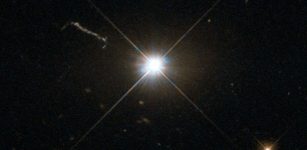Astronomers Discover Rare Stellar Marriage
Eddie Gonzales Jr. – MessageToEagle.com – Researchers from the University of Tübingen encounters a new type of star with unusual properties – a merger of two white dwarfs.
Artist’s impression of the merging of two white dwarf stars. Image credit: Nicole Reindl, University of Potsdam
Astronomers from the Universities of Tübingen and Potsdam have discovered a new type of star: while hunting for “hot stars” with the Large Binocular Telescope in Arizona, the team came across stars with unusual properties. While normal stellar surfaces are composed of hydrogen and helium, the stars found led by Professor Klaus Werner of the University of Tübingen are covered in carbon and oxygen, the ash from helium fusion. The exotic composition is all the more puzzling because the stars’ temperatures and diameters indicate that helium nuclei continue to fuse within them.
The results were published in the Monthly Notices of the Royal Astronomical Society.
The typical life cycle of a star like our sun begins with the nuclear fusion of hydrogen into helium. After that, deep inside the star, a nuclear reaction begins that converts helium into carbon and oxygen: the star “dies” over the course of millions of years and shrinks into a so-called white dwarf.
“We normally expect stars with the chemical surface composition of the discovered stars to have ended the helium fusion in the center and are close to the final stage of their development into white dwarfs,” explains Klaus Werner from the Institute for Astronomy and Astrophysics. It is well known that there are stars that are covered with carbon and oxygen instead of hydrogen.
The reason for this is suspected to be an explosive restart of helium fusion, which then brings the ash – carbon and oxygen – to the surface. “However, this event cannot explain the newly discovered stars. They have larger radii and perform helium fusion peacefully at their center.”
A possible explanation for the formation of these atypical stars is provided by a parallel published article by astronomers from the University of La Plata (Argentina), led by Marcelo Miller Bertolami. “We believe that the stars our German colleagues discovered were formed by a very rare type of merger between two white dwarfs,” says Miller Bertolami, first author of the accompanying publication.
White dwarf mergers in close binary systems can occur because their orbits are becoming increasingly spaced by gravitational wave emissions.
“This does not usually lead to the formation of a star enriched with carbon and oxygen,” explains Nicole Reindl from the University of Potsdam.
“However, we believe that in binary systems with very specific stellar masses, a white dwarf with a carbon-oxygen core can be disrupted by tidal forces. Its material is then dumped onto the surface of its white dwarf companion, leading to the formation of these exotic stars.” However, more precise evolution models are needed to fully explain the phenomenon found.
The stars were found as part of a large-scale search program in which researchers are tracking down short-lived, hot stars to better understand the final stages of stellar evolution.
The spectra of the stars are recorded and analyzed, for example to determine their chemical composition. Since these stars have little luminosity, large optical telescopes are required. The largest contributor to the new discovery is the Large Binocular Telescope in Arizona, consisting of two large primary mirrors, each 8.4 meters in diameter.
Written by Eddie Gonzales Jr. – MessageToEagle.com Staff











